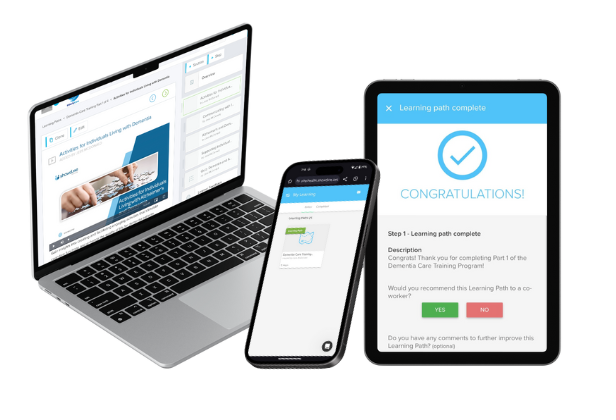Improve Employee Retention: A Guide to 3 Essential Strategies
Post - Improve Employee Retention: A Guide to 3 Essential Strategies
Expert organizational strategist shares what’s working now to improve employee retention in skilled nursing and home health.
Worker shortages are everywhere, and it’s especially dire in healthcare. In 2021, the caregiver turnover rate was 65.2 percent, and facilities for older adults are still constantly looking for help.
It’s costly to constantly hire and retrain new staff. Abby Waters, organizational consultant, leadership and team coach, and the founder of People, Science, Solutions, says, “Healthcare organizations should ask powerful questions about what’s working and isn't working. Most organizations have a healthy recruitment strategy but struggle to know how to keep people for the long haul. They must look outside the standard hiring and onboarding process and commit to being employee focused.”
What can care facilities and home health agencies do to attract high-quality caregivers and retain them long-term? There’s no easy answer, but some approaches can make a big difference for your company. Here are three key strategies to consider when looking to improve caregiver retention.
Focus on Employee Engagement to Improve Employee Retention
While patient care is the number one focus of healthcare, the truth is that you can drive better patient care and outcomes by putting employees first.
When employee care is your focus, you can avoid overworking and burning out your staff. That means you’ll be better able to attract and retain key talent.
How can you improve employee engagement? Here are some ideas:
- Make onboarding, forms and training easy to access and in your employees’ native languages
- Provide employees with good pay and benefits that are meaningful and easy to use
- Improve communication by contacting employees in ways they already communicate, such as text and email
- Hire adequate staff so employees aren’t overworked or carrying heavy caseloads
Waters explains, “With a robust employee engagement strategy, patient outcomes can soar even higher with happier employees.”
Promote Workplace Safety
Healthcare employees face physical, mental and emotional challenges every day. Protecting your employees and teaching them how to handle difficult situations is essential for caregiver retention.
Physical safety includes training on doing physical parts of the job, like lifting patients or carrying equipment. It also involves knowing how to respond if a patient becomes combative.
Harassment can happen between colleagues or from a patient to a caregiver. Patients who need care may be short-tempered, verbally abusive or emotionally inappropriate. It’s vital to train your caregivers on how to maintain proper boundaries and to stand up for your team when a conflict arises.
showd.me workplace safety training ensures your employees have easy access to the training they need to complete their jobs safely.
Use people-friendly technology to make employees’ job easier
For home health organizations, there is little or no face-to-face interaction with the company. This means that your communications and technology is the only time your staff interact with the company.
Leverage communications to be easy to use, from applying and onboarding to compliance training and updating HR forms. Here are some ways to make communication easier for employees:
- Distribute forms, letters and training in your employees’ native language
- Use mobile-friendly forms and software
- Ensure any required software includes a responsive help desk
Rather than focusing on price when purchasing new technology, instead prioritize ease of use for your end users.
Offer Training and Career Development to Improve Employee Retention
It’s easy for someone who is a caregiving professional to feel like there’s not much advancement available. But healthcare organizations that prioritize professional growth and even support higher education opportunities create a more meaningful workplace.
Waters says, “Most healthcare managers don't have any formal leadership or people skills training, and this is a huge pain point for the healthcare industry. Healthcare can't promote based on education or experience, they must look at competencies and emotional intelligence skills too.”
Most people aren’t born with those competencies — instead, employers need to provide training on leadership skills, people skills and strategic thinking. An SHRM study showed that employees with access to professional development opportunities are 15 percent more engaged in their jobs, which led to a 34 percent higher retention rate.
Attract and Keep the Right Talent
Post COVID-19, the healthcare industry has to be more creative than ever to recruit and retain talent. Waters says, “Companies doing well have been putting effort and money into looking at the whole person instead of just the worker. These companies engage employees on personal motivators, offer personal and professional development opportunities, flexible scheduling, remote or hybrid options, and coaching and mentorship experiences."
By taking these three steps, you can improve the work environment at your facility or agency, which will help you attract and retain top talent.
Increasing retention not only saves your organization time and money but also leads to better patient care and outcomes. Everyone wins!
showd.me offers compliance training as a service, as well as better onboarding and digital forms that are easy to use and accessible. Click here to schedule a demo

Let Us Show You More
See how showdme's unique service-first approach to training helps hundreds of healthcare organizations ensure compliance. Request a demo today!

